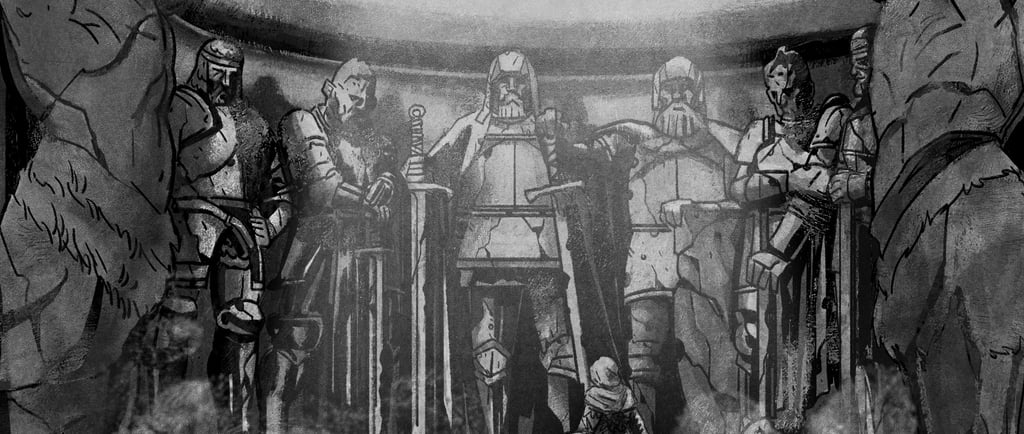Religion in Iskandria
A quick overview of the many different religious practices and their impact on the world
1/15/20254 min read


A myriad of different deities are revered across Iskandria, from powerful planar lords (like the ones worshipped by the different tribes in the Azari Archipelago), to ancient ancestors, such as Gewani the Ascended, worshipped in the Oxze Empire, and of course the more traditional pantheons, like the one worshipped in the Alderworth Kingdom. In the vast majority of cases, these are actual beings that live in the different planes of existence, occasionally manifesting in the Material Plane. They often bless their followers and ensure their will and precepts are followed, although this is something that varies widely, depending on the deity in question. Many deities have a “hands off” approach to their religions, and some don’t really seem to care if they have followers at all, while others, such as the Alderworthian pantheon, impose complex and rigid religious laws and systems to ensure things happen exactly according to their wishes. Regardless of all this, religion is not just a backdrop but an active and influential force in the lives of people and the world at large. It shapes cultures, politics, and personal beliefs, and it’s usually wise to keep in mind one’s actions when it comes to the gods.
Priests & Clerics
Priests and clerics are vital to their religions and communities. They lead worship, offer spiritual guidance, and provide support. Many, especially those devoted to deities like Hesie, act as healers, tending to both physical and emotional wounds. They often mediate disputes and offer comfort during crises. Additionally, they are well-versed in religious lore and history, taking on roles as educators and scholars. They teach the principles of their faith and study ancient texts, while also conducting significant rituals and ceremonies like weddings, funerals, and seasonal festivals to invoke their gods' favor.
Religious hierarchies vary wildly depending on the religion in question, with each having its own structure and orders. In the state-religion of the Duchy of Tyrros, for example, there's a clear hierarchy from priests to the Grand Theogonist. Some religions have specialized orders focusing on specific aspects of their faith, such as the Order of Balance, a militant group belonging to the Church of Ekoineme. These orders come with unique roles and responsibilities within their communities.
The power of priests and clerics goes even further, as many can call upon their gods to perform miracles or blessings, such as healing wounds, banishing the undead, or invoking divine protection. These powers are tangible proof of their gods' influence and favor, playing a crucial role in their communities and in gaining new followers.
The influence of priests and clerics extends into society at large. High-ranking priests often hold significant political power, affecting decisions at local and national levels. A clear example of this is the strong influence the Pantheon has over Alderworthian politics and society. Even lower-ranking priests are respected community leaders, serving as moral guides and helping people navigate daily challenges.
Temples & Shrines
Temples and shrines are often seen as the physical embodiments of faith, where the divine meets the mortal. They provide spaces for worship, reflection, and community gatherings, with each temple being dedicated to a specific deity or pantheon, mirroring the nature and domain of the god it honors. For example, a temple dedicated to Auna, goddess of Duty, might resemble a formidable fortress, while a way-shrine erected in honor of Ythe, Lord of Paths, is often no more than a few piled stones and a rudimentary idol.
These religious structures range in size and grandeur. In cities such as Veldonia, grand cathedrals often serve as the central hubs for their religions, hosting major ceremonies, housing high-ranking clergy, and storing valuable religious artifacts. They are also centers of learning and administration, where priests educate the faithful, record important events, and manage the church's affairs. In contrast, modest shrines can be found in unexpected places like forests, mountains, or along busy trade routes, offering travelers and locals a place to pray and find solace.
In many cultures, temples and shrines are not just places of worship but also cultural and social hubs. Religious festivals, often linked to the agricultural calendar or significant historical events, are celebrated with great pomp and ceremony at these locations. These festivals bring the community together, reinforcing their faith and enjoying various festivities. Rituals performed at temples and shrines, such as weddings, funerals, and rites of passage, mark important milestones in the lives of the faithful and are conducted with great reverence.
Furthermore, temples and shrines play a vital role in the local economy. Donations from the faithful help maintain the temples, support the clergy, and fund charitable activities (and often even wars). Many temples run hospitals, orphanages, and schools, providing essential services to the community. Pilgrimages to renowned temples and shrines attract visitors, boosting local trade and commerce.
In times of crisis, temples and shrines become sanctuaries for the frightened and desperate, with the clergy often acting as counselors and mediators, helping to resolve conflicts and heal the wounded, both physically and spiritually. Unfortunately, the opposite is also true, as many conflicts and societal problems stem from religious intolerance. Heresy is a capital punishment in many countries and regions of the world, with the Alderworth Kingdom being uniquely strict and intolerant. Almost every church belonging to the Pantheon has an order of inquisitors that are kept really busy by the different religious authorities.
Religious Festivities
Religious festivals often coincide with the agricultural calendar or significant historical events, and are usually marked by processions, feasts, games, and performances. Take the Festival of Winter in the Kingdom of Breccia, for example, which celebrates the founding of the kingdom and the end of the religious year with parades, speeches, and martial displays. Such festivals create a sense of continuity and connection to the past, reinforcing cultural and religious identity.
On the other hand, public rituals are more solemn and structured ceremonies marking important milestones or invoking divine favor. The most common rituals include weddings, funerals, and rites of passage.
Beyond their religious significance, festivals and rituals also have crucial social functions, as they foster a sense of community and belonging, uniting people in shared joys and sorrows. Festivals are times of merriment and social bonding, providing a break from hard work. Rituals, though often more somber, reinforce social bonds and offer comfort and support during times of change or loss.
The influence of festivals and rituals extends beyond the spiritual realm, impacting daily life in various ways. They shape the year's rhythm, dictate social norms and behaviors, and even affect the economy. For instance, festivals often feature markets and fairs where merchants sell their goods, and artisans display their crafts, boosting local trade and commerce.




